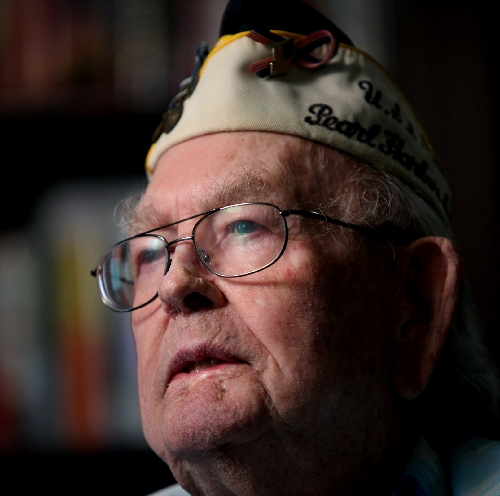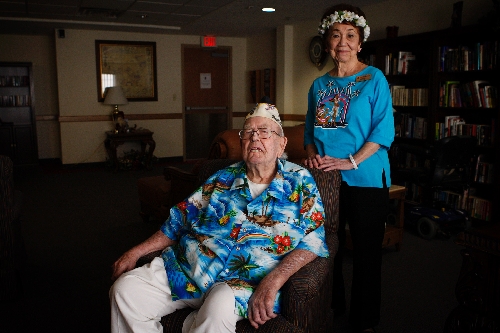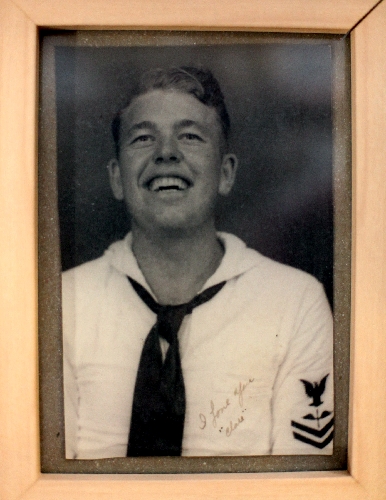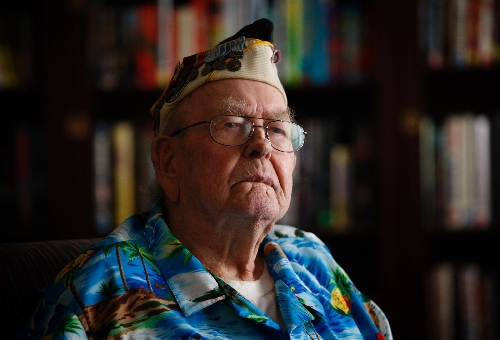Navy vet, Japanese-American remember Pearl Harbor




They were only a few miles apart when warplanes with big red spheres painted on their wings stormed over ships and homes.
She was a little girl of Japanese descent picking flowers in her front yard.
He was a strapping young sailor, a mess cook who had just cleaned up the Sunday morning breakfast table for 16 of his shipmates.
Within a couple of hours, the girl from Oahu and the seaman from Lemon Grove, Calif., would have something in common that few can claim Friday , exactly 71 years later: They survived the Pearl Harbor attack on Dec. 7, 1941.
Joyce Jones, 75, and “Clare” Clarendon Hetrick, 89, never knew each other over the seven decades that followed “the day in infamy” that thrust the United States into the deadliest war of all. That was until about a month ago, when Hetrick and his wife of 68 years, Jeanie, moved from Bullhead City, Ariz., to a seniors community in the southwest Las Vegas Valley.
Jones, who assists with activities for residents of the Acacia Springs retirement resort, noticed Hetrick’s Pearl Harbor service hat from the USS Arizona with its faded campaign ribbons and medals dangling above his forehead.
“He wears it all the time,” she said last week after the Hetricks had zipped down the hallway in their motorized chairs to get ready for an interview about his Pearl Harbor experience.
MEMORIES OF THE ARIZONA
Like the memories that burn in his mind of the battleship exploding after 10 Japanese “Kate” bombers pummeled it with armor-piercing shells, Hetrick holds close to his heart any reminder of the Arizona, now a submerged memorial to the 1,177 who went down with the ship or died during the attack that morning. About 335 of the Arizona crew survived.
At last count this summer, Hetrick said he is one of only 13 sailors from the Arizona still living.
At 6:05 a.m. on Sunday, Dec. 7, 1941, the Imperial Japanese Navy launched the first of 350 warplanes in a 90-minute span from six aircraft carriers. There were 183 in the first wave and 167 in the second. The raid – the pinnacle of Japan’s decade-long expansionist assault – also involved 30 submarines.
It took more than an hour for the first Japanese Zeroes to reach Kaneohe Bay Naval Air Station, where they began strafing the hangars at 7:48 a.m.
Hetrick, who had joined the Navy in 1940 at age 17 with his parents’ permission, had just finished bussing dishes and had taken a shower to get ready to go on liberty.
“I was about half shaven when all hell broke lose. Bombs are going off,” he said, recalling how he rushed to the deck to get a view. “I see an airplane going across the sky with a big red meatball on it. I knew then that we were in trouble.”
He ran to his battle station, the third-deck ammunition magazine, where he started handing up shells for the topside guns.
“We had about five rounds in and some big explosion knocked us off our feet,” he said. “We smelled smoke, and somebody says, ‘Get the hell out of here.’ We didn’t hesitate.”
The sailors scrambled to escape through a hatch, but somebody was blocking it.
“I told him, ‘We got to get out!’ But he said, ‘I can’t make it.’ So I pushed him through. Come to find out about 40 years later he was one of my good buddies, Clay Music. He had broken both hips. He said if you hadn’t pushed me out the hatch, I’d never had got off the ship.”
The Arizona was sinking fast. The quarter-deck, which is normally 15 feet higher than the water line, was now only a foot above it.
Hetrick, a poor swimmer who could only dog paddle, stepped into the harbor and headed for Ford Island about 75 yards away.
“The only thing I could think of was move. I don’t know whether I swam or ran across the water, but I happened to make it across.”
Before finding safety in an air raid shelter, he glanced back.
“You saw nothing but smoke, heavy black smoke. You couldn’t make out the ship.”
The entire harbor was chaos.
“Everything was either burning or sinking or trying to get underway,” Hetrick said. “We stood on the air raid shelter and watched the USS Nevada get under way. She was moored right in front of us.”
The Nevada, with the help of tugs, managed to make it to shallow water off Waipio Point. The ship was repaired, and her guns were used to pound the Normandy, France, coast during the June 1944 invasion. She returned to the Pacific in 1945 for the battles of Iwo Jima and Okinawa.
JAPANESE-AMERICAN MEMORIES
Jones, whose maiden name is Morita, was 4 years old at the time, and living with her parents and sisters in Honolulu.
“There were bullets in our neighborhood,” she said. “I was out by the walkway picking some violets to make a small bouquet when all of a sudden my mother tore down the steps, grabbed my arm and brought me in the house. We heard airplanes going by.”
A couple of hours later, her father returned from his job working on a crane at Pearl Harbor to make sure the family was safe.
“A Japanese plane with a big rising sun just whizzed over them and crashed into a water tank,” Jones said, recounting her father’s story.
As a soldier in the National Guard, he spent the rest of the day transporting the wounded to medical facilities.
Despite her heritage, Jones never felt others in her neighborhood viewed her family as foes of the United States.
“Hawaii is a melting pot of all different nationalities. We were Japanese. There were Chinese, Filipinos, all sorts of people but we all got along.
“Since I was born in Hawaii when it was a territory, I felt I was an American citizen. I thought I was more American than Japanese,” Jones said.
She later worked as a tour hostess for visitors to the Arizona memorial before moving to Las Vegas in 1984.
Hetrick continued to serve during World War II as a torpedo plane mechanic aboard the USS Saratoga when it fought in the battles for Midway, Wake Island, Guadalcanal and Iwo Jima.
At Iwo Jima, the Saratoga endured five kamikaze attacks by Japanese planes that crashed on the deck.
“I told one of my buddies, if they come back again, I’m jumping over the side.” He never had to jump.
After his Navy career, he spent 10 years in the Air Force and was a crew chief on a B-26 bomber.
In 1991, on the 50th anniversary of the Pearl Harbor attack, he visited the Arizona memorial and a salvage yard where he asked for and later received a rusted piece of metal from the ship. He keeps it in a glass-encased frame.
“That’s my prized possession right now,” he said. “I think of how many times I headed for liberty and back and forth to the ship. It was just like my home. In fact, it was my home.”
Contact reporter Keith Rogers at krogers@reviewjournal.com or 702-383-0308.












